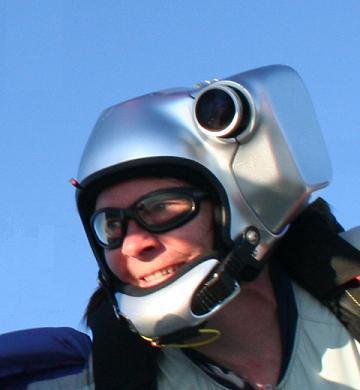Recommended Posts
AFFI 0
QuoteWe should teach Freefall and Canopy skills the same. They are equally important.
Jumper #1:
Totally screws the freefall portion of a jump but deploys the parachute on time and properly navigates the canopy piloting portion of the skydive and lands safely in an area free of obstacles. Jumper #1 repacks and is on another load that day to go practice freefall skills again.
Jumper #2:
Illustrates perfection in freefall but does not deploy their parachute on time, makes poor decisions in navigating their canopy and lands in an area that is not free of obstacles resulting in a serious injury (or worse). Jumper #2 is not able to skydive again for an extended period of time (if ever) while healing from the injuries sustained on their landing.
In a perfect world the freefall portion and canopy piloting portion of a skydive are both successful without injury. In the real world people make mistakes, especially when they are still a novice/student level skydiver. I have never heard any stories about a skydver in the plane on their way to altitude with a femur sticking out.
Midair freefall collisions can be catastrophic as well; perhaps this is why we never see a skydiver with 19 jumps on Big Ways…
Which jumper would you rather be? Number 1 or number 2?
Mykel AFF-I10
Skydiving Priorities: 1) Open Canopy. 2) Land Safely. 3) Don’t hurt anyone. 4) Repeat…
Skydiving Priorities: 1) Open Canopy. 2) Land Safely. 3) Don’t hurt anyone. 4) Repeat…
I would rather see someone jump with someone with 500 jumps that can't teach than do solos because they don't have the money to pay a coach or there are no coaches available.
Lets think about this.Early freefall skills are not rocket science.We are talking about falling relative to another body,docking,tracking.I'm not suggesting a free for all where the new guy gets on any skydive he wants.I'm saying that someone with 20 jumps jumping with someone with 100 jumps without a coaches rating is not the most dangerous thing that can happen.Thats the way it use to be and people didn't die every weekend because of it.I'm just saying that the sport was not necessarily more dangerous the way it was and I don't believe it is any more safe now,but it damn sure costs someone more to get an A licence.
.
Lets think about this.Early freefall skills are not rocket science.We are talking about falling relative to another body,docking,tracking.I'm not suggesting a free for all where the new guy gets on any skydive he wants.I'm saying that someone with 20 jumps jumping with someone with 100 jumps without a coaches rating is not the most dangerous thing that can happen.Thats the way it use to be and people didn't die every weekend because of it.I'm just saying that the sport was not necessarily more dangerous the way it was and I don't believe it is any more safe now,but it damn sure costs someone more to get an A licence.
.
Andy9o8 0
QuoteWhich jumper would you rather be? Number 1 or number 2?
When I was a student I had "Number 1" tattooed to my forehead.
(Hey! Welcome back!)
For quit a few jumper it is rocket science. I have been running coach courses sense the beginning, and I do a lot of coaching, for free. And there are a lot of D license skydivers I would not let jump with anyone. Plus not everyone can teach, this is a critical time in the beginer students long term carreer. I don't think that there are a lot of coaches out there that know what there doing, but that falls back on the course director and the individual. I also hear form a lot of old time instructors that a individual should be a coach for at least one year before they get their instructor rating just like with the old jumpmaster program. The student can work without a coach or instructor on the skills to complete the A license card. And then when ready basically test out. Almost every big sport out there requires money.
Education is the best way to prevent accidents.
Education is the best way to prevent accidents.
AFFI-E, Tandem I-E, S/L I-E, IAD I-E, Coach I-E
Students are our future teach them well
Students are our future teach them well
labrys 0
I really don't see it stated anywhere in the original post that D license holders are going to be allowed to teach or instruct students. It says that they can jump with them.
That leaves a unlicensed jumper with 3 potential options. Solo, get a coach, do up to a 4-way with at least 1 D license holder.
Am I missing something?
That leaves a unlicensed jumper with 3 potential options. Solo, get a coach, do up to a 4-way with at least 1 D license holder.
Am I missing something?
Owned by Remi #?
What I think a lot of people are missing in this is that without proper training.... You can become a bad combination of both jumpers 1 and 2.
Don't get me wrong the USPA did a great thing in producing the video Fly to Survive. We plan on incorporating it into Safety Day at our dropzone.
Where they went wrong is in lessening the training required for jumpers to instruct students. I've seen people argue on this forum that jumpers with 100 to 200 jumps are not experienced, yet you are only required to have 100 jumps to get a coach rating. Do you feel that it is okay to have a person with 100 jumps teaching a jumper turns for the first time? With this new system they will be allowed to take a static line student as soon as they complete their clear and pull(7th jump). That means the student will have no other freefall experience. Would you have a coach do the same thing for AFF. That means it will be the students 4th jump.
This argument is not about what is more important to the student (canopy skills or freefall skills). It is that the USPA is dropping their standards for student instruction.
You can't preach safety and do this at the same time. Instructional Rating courses have been implemented for a reason. A person looking to be an Instructor is evaluated on their ability to fly with and teach a student. D-License holders are not instructors or coaches.
Don't get me wrong the USPA did a great thing in producing the video Fly to Survive. We plan on incorporating it into Safety Day at our dropzone.
Where they went wrong is in lessening the training required for jumpers to instruct students. I've seen people argue on this forum that jumpers with 100 to 200 jumps are not experienced, yet you are only required to have 100 jumps to get a coach rating. Do you feel that it is okay to have a person with 100 jumps teaching a jumper turns for the first time? With this new system they will be allowed to take a static line student as soon as they complete their clear and pull(7th jump). That means the student will have no other freefall experience. Would you have a coach do the same thing for AFF. That means it will be the students 4th jump.
This argument is not about what is more important to the student (canopy skills or freefall skills). It is that the USPA is dropping their standards for student instruction.
You can't preach safety and do this at the same time. Instructional Rating courses have been implemented for a reason. A person looking to be an Instructor is evaluated on their ability to fly with and teach a student. D-License holders are not instructors or coaches.
You are correct. but it goes back to teaching the student the correct information. If the D license skydiver is not teaching the or if you would like working on the correct techniques or the drop zones syllabus then we are confusing the student and he or she is getting mixed information. Again this is critical time in any ones learning.
www.airrageskydivingservices.com
www.airrageskydivingservices.com
AFFI-E, Tandem I-E, S/L I-E, IAD I-E, Coach I-E
Students are our future teach them well
Students are our future teach them well




Instructor Examiner, USPA
Co-author of Parachuting, The Skydiver's Handbook
Share this post
Link to post
Share on other sites